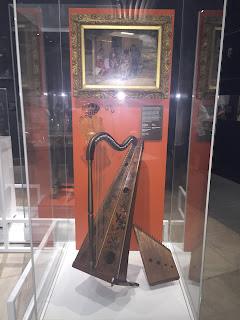May 20, 2016: Gallery Exploration Tour at the Los Angeles Natural History Museum
Becoming L.A.
 |
| Entryway into Becoming L.A. |
On May 20, 2016, I went to the Los Angeles Natural History museum to attend the Gallery Exploration Tour of "Becoming L.A." This tour was quite fitting for our class, as it explained how technology and art innovate and improve throughout time, giving light to what we can now be so appreciative for. This tour also exemplified how the future is uncertain, as technology is continuing to expand and people are becoming more and more creative in how we can utilize science, art, math etc. to create new inventions.
 |
| Oil Pump Jack (1920s) |
The tour explained that Edward L. Doheny was responsible for the discovery of oil at Second Street and Glendale Boulevard in Downtown in 1892. This discovery set off the oil boom, which led to the drilling industry. This is responsible for how we run so many of our machines today. However, during this time there were many oil strikes because oil was polluting the environment. Today, we see that technology is becoming more eco-friendly with machines running on solar energy. This is just one example of how oil pumps became a use of technology to create something new, a form of art in itself.
 |
| Tourist Automobile (1902) |
The event then discussed the introduction of the wooden-body gasoline-powered tourist automobile. This was one of the earliest start-up businesses in Los Angeles in 1902. The inventor, Ralph B. Hain, combined his woodworking knowledge and his carpentry tools to make the cars. His company did not last long, but it influenced the automobile industry forever. Inventors began innovating new cars and making new companies, and this all started from his invention. His car was once a technological innovation and now stands as an art piece for people to appreciate the evolution of automobiles that he helped begin.
 |
| Harp (Early 1840s) |
 |
| Proof of Attendance |
The last part of the event that I wanted to focus on was the music and dance exhibit that also relates to our class. Music and dance is one of the oldest art forms to exist. Women traditionally played guitar and men played the violin. This was surprising to me as I feel like it would have been the opposite with traditional gender roles. I view the violin as softer and more feminine, while the guitar is more hardcore and manly. Looking at this old instrument also showed how art and technology is continuing to innovate. I love that music continues to play an important role in our culture, as it brings people together and allows everyone to interpret and create their own musical numbers. Overall, my experience at this museum was amazing. I love learning about the technology startups in Los Angeles, and I saw how applicable this museum was to our class. I would definitely recommend it to anyone!









